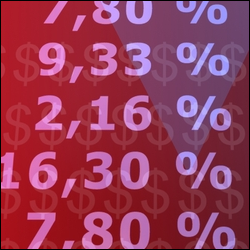
- Limit Your Trading Capital
- Limit Your Risk with Small Trade Sizes
- Stop Loss Orders
- Guaranteed Stop Orders
- Trailing Stop Orders
- Limit Orders (Take Profit Orders)
- Using Multiple Trading Orders
- Don’t Trade
- Risk Management in Volatile Markets
Whether you trade using financial spread betting, CFDs, ETFs, ETPs or traditional stock trading etc. it is likely that you will lose money on some of your trades.
If you are spread betting and/or CFD trading it’s important to realise that these products are leveraged, and therefore high risk. As such, your risk management is very important with these products.
Also, with any trading, you should only speculate with money that you can afford to lose. If in doubt, seek independent financial advice.
Below, we discuss a number of ways that you can reduce the risk to your trading capital.
Limit Your Trading Capital
Some trading experts believe you should not risk more than 3% of your capital on a single spread bet. This means that if you had £2,500 in your trading account, a single trade should never cost more than £75.And that means £1/pt or £0.5pt stakes.
Limit Your Risk with Small Trade Sizes
Related to the above point, one way of reducing your risk is to keep your trade sizes small.Most firms will let you trade £1 per point, whilst some firms will even let you trade in smaller sizes, see our guide to low stake sizes for more details.
To gain a small amount of exposure to the world stock markets, you could just trade the Dow, FTSE 100 or German DAX. Again, most firms offer these markets.
If you speculate on the FTSE to go up with a £2 per point stake, and it goes up by 60 points then you would make a profit of 60 points x £2 per point = £120.
Note that you can normally trade the markets in dollars, pound sterling or euros. If you want to trade in euros then 60 points x €2 per point = €120.
Of course, if you are trading £2 per point and the market moves against you by 75 points then you would lose 75 points x £2 per point = £150.
And this brings us neatly to another important risk management feature, ‘Stop Loss’ orders.
Stop Losses
Stop Loss orders are very useful because they will close your trade if you are losing money but they won’t close your trade if you are winning. There is normally no charge for using a Stop Loss.Nearly all firms offer some form of Stop Loss, and to help with your risk management, some firms automatically attach a Stop Loss order to your trades: If your spread betting company automatically attaches a Stop Loss order to your trade and you don’t like the level they have placed it at, then, provided you have the funds in your account, you can move the Stop to almost anywhere you want, e.g. with FinancialSpreads you can place a Stop Loss order within 1 point of your opening trade. If we continue with the above example, you could have set a Stop Loss 30 points away from your opening trade.
If so, and if the UK market moved against your position by 75 points, instead of losing £150, you’d only lose 30 points x £2 per point = £60.
Of course, if you correctly predicted the direction of the market then you would still make a profit of £130 if it moved 65 points or £70 if the FTSE 100 index moved 35 points.
Stop Losses are therefore very useful in most market situations. However they are not ‘guaranteed’.
If the market you are trading ‘gaps’, or jumps, across the level you set your Stop Loss at then your trade will be closed at the next price that is traded. For more on this see our guide to market gaps.
You can protect yourself from gapping by using a Guaranteed Stop order.
Guaranteed Stops
Guaranteed Stop orders are identical to Stop Loss orders except that:- Even if a market gaps, your trade will still be closed at the level you set your order at.
- You generally have to pay a small premium for the extra insurance. This often comes in the form of a wider spread, e.g. a 4 point spread, rather than a 1 point spread.
- You cannot always set a Guaranteed Stop as close to your opening trade as you can with a normal Stop Loss order. E.g. if you are trading the FTSE 100 (UK 100) with FinancialSpreads, you can place an ordinary Stop Loss within 1 point of your opening trade, however, a Guaranteed Stop needs to be at least 30 points away.Having said that, unless you like very tight Stops, or you are trading disproportionately large stake sizes, having to set a closing order 30 points away from your opening trade won’t normally cause a large problem with your risk management.
- Volatile markets, i.e. markets more likely to gap.
- Around key economic announcements such as the monthly US non-farm payrolls report or an FOMC update on Tapering, i.e. events where the markets are more likely to gap.
- Illiquid markets, these are more likely to gap than liquid markets.
- When the markets are looking generally volatile, and easily spooked, particularly if you want to keep a trade open over a weekend and you want to insure yourself against any nasty surprises.
Let’s say you bought the Dow Jones index for £2 per point at 16,100, if so, you could set your Guaranteed Stop at 15,950.
This way, should some sudden market volatility push the US index lower, and straight to 15,900, your trade would still be closed out at 15,950.
In this example the Guaranteed Stop might cost 4 points x £2 per point = £8. However it would save you 50 points x £2 per point = £100.
For more, also see Guaranteed Stop Loss orders.

Trailing Stops
An extension of Stop Loss orders is the Trailing Stop.This works like a normal Stop Loss but the level it is set at is not static. A Trailing Stop order will trail a profitable move to help lock in a profit.
Note that Trailing Stops are not normally guaranteed.
For a worked example, see Trailing Stops.
Limit Orders (Take Profit Orders)
Limit orders, also known as Take Profit orders, are another useful form of risk management.With a Limit order you simply set the profit level you are happy with.
Should the market hit the level of the Limit order, then your trade will be closed and your profit will be locked in.
Naturally, these orders can be very useful in strong trends. And, as with most trading orders, Limit orders are useful when you can’t keep an eye on your trading screen and/or if you are trading volatile markets.
Using Multiple Trading Orders
You can normally apply multiple orders to the same trade, e.g. you can have a Limit order and one of the following Stops:
Don’t Trade
The simplest way to reduce your risk is to avoid trading. Yes, there is no upside and it’s annoying when you correctly predict the direction of a market, but there is no downside and no trading costs.Risk Management in Volatile Markets
Below, an interesting look at risk management by Shai Heffetz, InterTrader, 3-Oct-2011 Unfolding world events always have the potential to cause significant volatility in the financial spread betting markets and this can cast doubt on many traditional spread betting risk management techniques.The question remains: have we really moved beyond the events of 2008, and do we truly understand volatility and the accompanying risk?
Risk Management vs Volatile Markets
For years, traders have used statistical models to try and predict future market movements.These models mostly rely on the fact that events tend to show a ‘normal’ distribution. Within any given 24-hour time frame, the probability that the price of a trading instrument will move up or down with a given percentage can usually be fairly accurately estimated.
Over the last few years the accuracy of many of these statistical models has become questionable. We often see events that are ‘supposed’ to happen no more than once every fifty years actually occur twice over the course of a few months.
The reality is that the future has proven to be less predicable than we first thought. In this truth lies the reason why so many traders lost such a lot of money during events such as 9/11 and the financial meltdown of 2008.
If our trading systems more fully incorporated the realities of an uncertain market and we had plans in place to react to these events, most traders would have survived them far better.
Where does this leave the ordinary trader?
Risk Management Techniques
Serious doubt has been cast on many of our risk management techniques for their inability to properly deal with so-called ‘Black Swan’ events.These are extremely rare, unexpected events that, when looking back, often seem totally predictable. An often quoted example is the mortgage meltdown.
How is it possible that we missed all the obvious signs and allowed such an event to wipe trillions off the balance sheets of private and corporate investors?
Hedging
Hedging is a time-honoured way of protecting yourself against a volatile market.If you have a significant trade on the gold spread betting market, for example, you can hedge your portfolio using a short trade at a relatively small cost compared to the potential loss during a Black Swan event.
If there is a proven correlation between the price of gold and that of another commodity, you can even use cross asset hedging to protect your portfolio.
Also see ‘Hedging with Spread Betting‘.
Portfolio Management
Portfolio management is also very important when it comes to minimising risk.Novice traders often make the mistake of investing all they have in a ‘hot’ share, only to be proven wrong and wipe out their trading account.
A well-balanced / sized portfolio might not double your money every 7 days, but it will help you to protect your capital, which is vital for any serious trader.
Decision Making Process
The risk management decision making process should be two-fold.Firstly, as far as possible, identify and quantify the risk levels of the trade.
Secondly, draw up a strategy that is consistent with these risk levels, taking into account your investment goals.
The importance of following your spread betting strategy can not be over emphasised.
If a Black Swan event should happen today, closely following your trading plan could make the difference between being wiped out and surviving until another day.
Useful Ways of Tracking Volatility
Below, BetOnMarkets look at a few different ways that you can track volatility- Narrow Range Bars (NR7): The day’s ‘range’ refers to the difference between the day’s low and the day’s high. Identifying the day with the narrowest range of the last 7 days can give you clues as to when the market is likely to experience an upswing in volatility.
- Bollinger Bands: Bollinger Bands can be a useful predictor of imminent market movement.When they are contracting, look for a break out. When they are expanding, look for consolidation.
- VIX: The VIX is a measure of implied volatility in the options market.Extreme readings of the VIX can represent fear or complacency depending on cycle of the market. When the VIX is high, the markets tend to act randomly.
- Check Multiple Time Frames: When you review the charts, check multiple time frames.I.e. view the trend from a broader perspective. A weekly or a monthly chart can help show just how strong a trend actually is.

